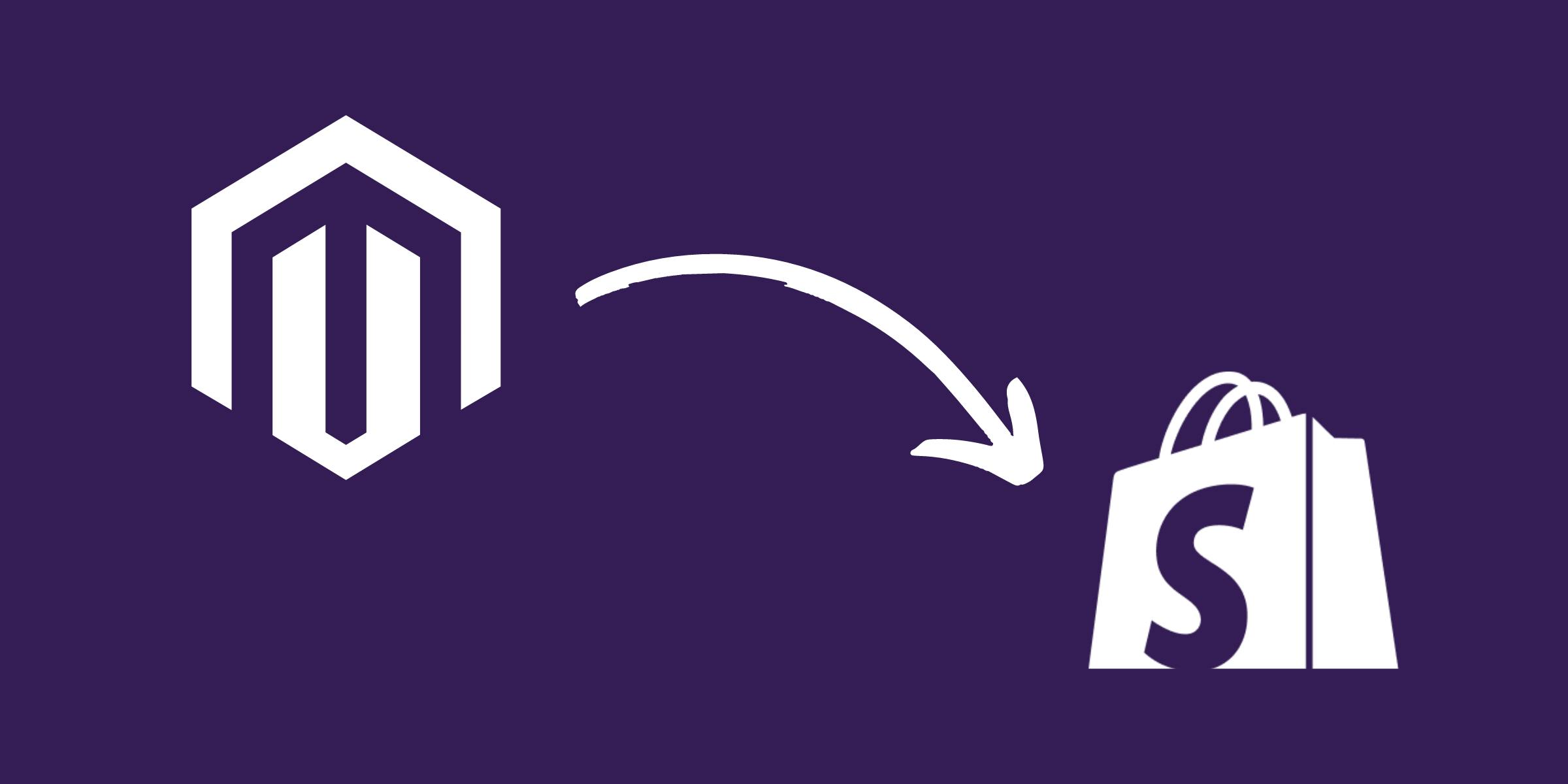Moving from Magento to Shopify or BigCommerce

Many SME and Mid Market ecommerce businesses are calling time on Magento (Adobe Commerce), choosing instead to replatform to SAAS solutions like Shopify and BigCommerce. So, how do you know if the time is right to move, and what to move to? In this article we’ll break down the main considerations to help you make the right choice.
The last few years have seen Magento businesses faced with a swath of costly security patches and updates. With such high costs involved in maintaining security and standing still, many retailers are turning their back on the platform looking for lower costs and less stress in the world of SAAS solutions.
Magento 2: A powerful & customisable platform, but perhaps over-complex for most
Magento remains a powerful platform - and it’s certainly a good choice for the right business - but for those who don’t have the scale or complexity in their business operations to warrant it, it’s tough to make the case to stay put.
In recent years, the ground made up by platforms like Shopify and BigCommerce in the SME and Mid Market space has been significant. Many of the features that were previously differentiators for Magento are no longer unique, and the alternative can deliver a far simpler life for ecommerce managers and business owners.
Time’s up: Knowing when it’s time to make the move
In our experience with clients reaching the end of their life with Magento, there are a few common tell-tale signs that it might be time to migrate from Magento to Shopify or BigCommerce. While we’re not saying that these are universally true, the following would be red flags in your experience with Magento:
Online turnover less than £1m
While it’s not a hard and fast rule, we would generally be surprised if a business turning over less than £1m in annual revenue couldn’t be more profitable on a SAAS platform like Shopify or BigCommerce.
Everything breaks!
Particularly if your initial Magento build was on a shoestring, you might find that more and more of the functionality breaks with every update, turning the initial cost-saving into a false economy.
Unable to add the new features and functionality that you want
If you find that the complexity and development involved is preventing you from adding the new features and functionality that you want, at the rate that you want, then it could be time to move. Particularly if you find that affording the improvements is becoming difficult.
Very little custom work or complexity in your ecommerce processes
If you have a fairly straightforward ecommerce model, with nothing particularly custom in your requirements, then chances are you could achieve the same for less on another platform. Even for B2B businesses, where Magento used to be a natural fit, the advances made by other platforms have significantly closed the gap.
Flexibility in payment providers
If you’re flexible in the payment providers you’d be willing to accept, then that certainly makes a move to Shopify easier - but even so, BigCommerce can still support a lot more flexibility in the checkout than Shopify, and reduce your costs versus Magento.

Magento to Shopify: The market leader makes sense for most
Shopify has put huge investment into the SME and Mid Market space in recent years and has grown into a powerful and fully-featured platform that can support everything from the most basic first site to huge and complex builds. Here are the main reasons that a move to Shopify would make sense.
Lower ongoing costs and Total Cost of Ownership (TCO)
When you factor in support and development costs, Shopify is generally more affordable than Adobe Commerce, especially for small businesses.
A user-friendly interface
Shopify is known for its user-friendly interface which makes it nice and easy to manage your store with the minimum of fuss and developer support.
Easy expandability with thousands of apps
Shopify’s app ecosystem is the biggest of any platform on the market, making it quick and easy to find a solution for most of the common challenges facing a business like yours.
Despite the rapid innovations, Shopify is still not a good fit for every retailer.
”Less reliance on developers
While you’re unlikely to be able to go it entirely alone on Shopify, the requirement for Dev support is vastly reduced versus Magento.
A strong checkout experience with Shop Pay
While to many it’s seen as restrictive, there’s no denying that the Shopify checkout experience is well thought-out and powerful, with Shop Pay being a popular added bonus.
More scalability
The solution can easily handle large volumes of traffic, including seasonal peaks. We know first-hand the pain of trying to get self-hosted solutions to cope with peaks in traffic, in situations where Shopify would barely break a sweat.
Easy international expansion
It’s easy to set up multi currency and multi language with Shopify, making international expansion a much more straightforward experience than it is with Magento.
Simpler security
Coming from a world where you’re responsible for your own updates, a SAAS based platform is so much simpler - with the most significant security updates taken care of for you.
Unified commerce
By combining Storefront, B2B and POS, all in one solution, you can streamline your infrastructure and maintain a clear single view of the customer and inventory.
Continuous development
Shopify has over 4000 developers working on its platform and is constantly innovating - adding features like B2B functionalities, a powerful headless solution (Hydrogen) to the launch of Unified Commerce to cater to larger enterprises.
24/7 support
Shopify has round the clock support, should you ever need it.

Potential pitfalls: When migrating to Shopify isn’t a good fit
Despite the rapid innovations, Shopify is still not a good fit for every retailer. Here are a few of the reasons why Shopify might be problematic for your business.
Checkout customisation
If a highly customised checkout or payment flow is crucial to your business model, Shopify might not be the best fit.
Specific payment providers
While Shopify does support many payment providers, it does attempt to channel shops to use Shopify’s own Shop Pay payment option.
Shopify charges a higher percentage of order value in fees if Shop Pay isn’t offered as an option.
Only one primary, on-page, payment method can be enabled at once. As Shop Pay is a primary payment method, this means no other on-page card payment options without incurring the above fee.
Off-site payment providers such as PayPal are available, but the limitations mostly apply to the primary card payment method.
3rd party payment providers may be restricted. Braintree, for example, can be used if paying the additional percentage mentioned above. However, the Braintree Shopify integration doesn’t support Braintree Vault (saved card) payments.
Other payment providers such as Elavon (formerly Opayo and SagePay) redirect off the site to complete payments like PayPal where the Magento integration might work on the page.
High transaction fees
Shopify charges transaction fees on all sales, which can add up over time. Shopify may not be affordable for high volume, low margin businesses. These transaction fees apply to subscription payments as well, meaning a company with an established large subscription base could find migrating to Shopify to be more expensive than their legacy systems.
Multi-brand requirements
Shopify doesn't allow managing multiple brands under one platform. Retailers on Shopify plus can create expansion stores but they must be…
- Extensions of the main brand
- Identical to the main brand with respect to store name and other branding
- Carrying the same types of goods and services as the main brand
Platform lock-in
Certain retailers may prefer not to be tied to a platform where Shopify maintains full control of the code, leaving them with no option for hosting elsewhere. If Shopify decides to double its fees, stop supporting a service that you use (e.g. Braintree), or to change its terms of service, then you either have to go with it or develop a whole new website elsewhere.
Unusual legal requirements
Shopify is a big player with a huge number of retailers on their books. They are very unwilling to make any changes to their legal terms. This might not ultimately be acceptable to your own internal legal team, if they object to conditions within Shopify’s standard contract.

Magento to BigCommerce: All the benefits of SAAS in a more flexible package
We’ve had some refreshing conversations with BigCommerce recently where they’ve been really up front about the areas that they’re not trying to compete with Shopify. And the good news for existing Magento retailers is that they present a really strong alternative to Adobe in ways that Shopify is not. Here are a few of the areas that make BigCommerce a great option for your replatforming.
Checkout flexibility
If you’ve got unusual checkout processes or requirements, or you’re tied-in to specific payment providers and unable to switch, then BigCommerce provides far more flexibility than Shopify in this regard. Whatsmore, they’ve had independent verification on their checkout to show that it’s arguably just as powerful as Shopify’s in terms of pure conversion.
A more open solution
While Shopify has a huge app ecosystem, it’s still quite restrictive in how they want you to use and customise the system. BigCommerce on the other hand is much more open and natively customisable, if you’re looking for unusual integrations or customisations.
Multi-storefront
A real feather in the BigCommerce cap is its multi-storefront solution, which is flexible in all the ways in which Shopify’s expansion store setup is not. BigCommerce allows for multi-brand D2C businesses to offer differentiated frontend experiences while still maintaining streamlined backend stock management.
Better B2B
Partly another benefit of the multi-storefront offering and thanks to their dedicated B2B edition, BigCommerce can offer a more fully-functional and feature rich B2B solution than Shopify. It might be overkill for some, but it’s worth paying careful attention to the differences if B2B is an important factor for you.
Internationalisation
Again, another advantage of the multi-storefront setup is in terms of internationalisation. The multi-language, multi-currency, multi-region setup might not be as straightforward as Shopify Markets, but it can deliver a few important benefits, depending on your requirements.
With Multi-Storefront you can offer multiple localised storefronts from one backend, which could be more efficient than using separate Shopify expansion stores. Despite the single backend instance, you still get control over everything you need at a local level, while saving on app and extension costs versus an equivalent expansion store setup.
Composability
While Shopify has made significant progress in opening up its APIs and supporting Headless and Composable solutions (with Components, Hydrogen and Oxygen emerging in recent years) BigCommerce is generally considered to be a more composable-native product. They’ve been doing it for longer, they’re MACH Alliance members, and they can demonstrate a strong capability in this area.
Willingness to work with you
While Shopify is very unwilling to bend on areas like legal terms and conditions, BigCommerce can be found to be more approachable. They’re often willing to work with you and negotiate in ways that Shopify are not.

Replatforming from Magento to Shopify or BigCommerce: Making your migration a success
Any ecommerce replatforming is inherently risky, and while moving from Magento to a SAAS solution isn’t necessarily more risky than any other move, there are a few areas that need careful attention.
Search Engine Optimisation (SEO)
SEO is a critical risk in any replatforming. Really, the aim should be to change as little as possible during the migration itself. Sadly, when it comes to a Magento to Shopify move in particular, there are some real limitations in URL structure, which mean that most if not all URLs in a site will need to change. The risk isn’t insurmountable, but takes careful management to minimise the impact on organic performance.
Data migration and service maintenance
Migrating data from Adobe Commerce to Shopify or BigCommerce can be complex. For example, passwords can’t be imported from one system to the other, so all customers have to reset their passwords.
Similarly, while new checkout solutions like Shop Pay offer a slick and seamless experience, be aware that card tokens stored by customers in old solutions will be lost. This will undoubtedly have an impact on user experience in the short term. Ensure your development agency has a solid plan to transfer as much data as possible and minimise disruption for users.
Custom functionality and extensions
It’s important to identify any and all custom functionalities or extensions implemented in Magento and assess whether similar functionalities are available in Shopify or BigCommerce. If not, developers may need to develop custom solutions or find suitable Shopify apps to replicate the functionality.
Theme choice
Shopify and BigCommerce are very flexible solutions in terms of frontend design and functionality, but using a starter theme can help to speed up development. That said, you should give careful consideration to the features and build quality of any theme that you choose.
While some can offer a huge range of features out-of-the-box, you can pay a speed penalty in terms of bloat code from unused features. Starting with a cleaner initial theme and developing it to your specific requirements can be more sensible and streamlined.
Make the right choice: Choose an experienced partner
Considering the switch? To ensure that you make the right move, it’s imperative to choose a partner that has the skills and experience to make your move a success. The good news is - we can help! Get in touch to discuss your specific needs and see if a move to Shopify or BigCommerce is the right fit for your business.






